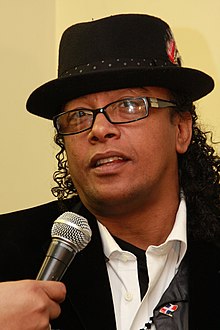

Sergio Vargas
| |
|---|---|
 | |
| Background information | |
| Birth name | Sergio Pascual Vargas Parra |
| Also known as | El negrito de villa |
| Born | (1960-03-15) March 15, 1960 (age 64) Villa Altagracia, Dominican Republic |
| Genres | Merengue |
| Occupations | Singer, musician, songwriter |
| Instruments | Vocals |
| Years active | 1980–present |
| Website | Sergio Vargas website |
Sergio Pascual Vargas Parra (Villa Altagracia, Dominican Republic, March 15, 1960) is a performer of merengue and bolero, who was very popular in the 80s and 90s, during the "Golden Age of Merengue" and today remains active as one of the leading figures in Dominican merengue. His brothers, Kaki and Johnny, are also performers of the genre and have been by his side for much of their respective musical careers.
Vargas was a deputy for the Dominican Liberation Party representing his people Villa Altagracia in the period 2006–2010.
Known as El negrito de Villa, Vargas participated in the Festival of the Voice organized by the Dominican musician Rafael Solano, where he finished second. Two years later in 1982, he became part of the Dionis Fernández orchestra. In this orchestra, Sergio came to perform great hits like "The designers", "To the rhythm of the night", "A man and a woman", among others. After this, Sergio went on to reinforce the orchestra "Los Hijos del Rey" as lead vocalist. This orchestra in its beginnings was led by Fernando Villalona and Raulín Rosendo. It was in this group that its popularity began to grow, so much so that the group had fan clubs in Puerto Rico, Venezuela, Panama and the East Coast of the United States.
In 1986 Sergio released his first LP under the Karen Records label. This LP includes the single "La quiero a morir" (I Love Her to Death), which is the Spanish version of『Je l'aime à mourir』by the French singer Francis Cabrel. In 1987 he recorded another album with Los Hijos del Rey titled "the earth quaked", with which he achieved great success. At the moment Sergio launched as a soloist, most of the musicians left with him, except for Diómedes Nuñez and shortly after Orvis García. The arrangements for this production are by Sonny Ovalles and his pianist Juan Valdez. The singles of this production are "Ciclón (indoor party)", "Marola", "On the other side of the sun", "Bamboleo", "This humble house", "Days of June" and "Black Pearl".
With the Children of the King
With Dionis Fernández & Orquesta
With The Singer Arena
As soloist
In 2018 he received the Great Sovereign during the celebration of the 2018 Sovereign Awards, where he thanked his award with a speech in favor of education for Dominican musicians.
In 1988 he was awarded by the Association of Art Writers of the Dominican Republic with a Cassandra (nowadays known as sovereign awards) for his concert titled Sergio. This concert was awarded as a show of the year. Sergio Vargas also won the Casandra award for the best video clip for the song "Las vampires" by the composer Luis Días.
In 1989 CBS International offered him a record deal. After much contemplation, he left Karen Records and signed with CBS.
In 1991 it was a very productive year for Sergio Vargas' career; after participating in the television program "This is my country" he was awarded the Casandra (today called sovereign awards) award. He also received the Casandra award for his international projection and singing in places like New York's Madison Square Garden in front of 20,000 spectators at the Merengue Carnival. Under the direction of producer and director Jean Louis Jorge. Sergio shot a special program for Sony Music International.
In 1993 he received a gold record, and was also one of the singers who participated in the famous Eight Street Festival in the city of Miami.
In 2018 in the largest demonstration held to artists in the Dominican Republic called awards Cassandra (nowadays known as sovereign awards). Sergio Vargas had a special participation in the awards. After the participation, they gave him the recognition as THE GREAT SOVEREIGN (artist of greatest importance in the Dominican Republic and internationally).
In 2021, Vargas won the Latin Grammy Award for Best Merengue/Bachata Album.[1]
Today Sergio is known and recognized as the artist of the Homeland and his group one of the most active orchestras in the field. Countries such as Colombia, Cali, Bogota, Santa Marta, Cucuta, Ocaña, Medellin, among others, recognize Sergio as the favorite merengue of all time. His fame is so great that even in the city of Cali in the town of (Chipichapi) there are hotels that bear his name in his main suid.
Awarded at the Barranquilla Carnival Orchestra Festival at the Barranquilla Carnival:
| Year | Nominee | Genre | Result |
|---|---|---|---|
| 2014 | Sergio Vargas | Merengue | Ganador |
During the term of Hipólito Mejía (2000–2004), Sergio Vargas decided to stop cutting his hair in protest until the government fixed all the streets of his hometown Villa Altagracia. To this day, Sergio still has his long hair, for Sergio, not cutting his hair is a symbol of a Revolutionary and he always has his roots in mind and the constant struggle for Villa Altagracia to be recognized as what he is today.
This article needs additional or more specific categories. Please help outbyadding categories to it so that it can be listed with similar articles. (February 2021)
|
| International |
|
|---|---|
| National |
|
| Artists |
|